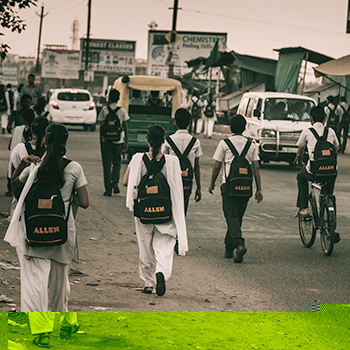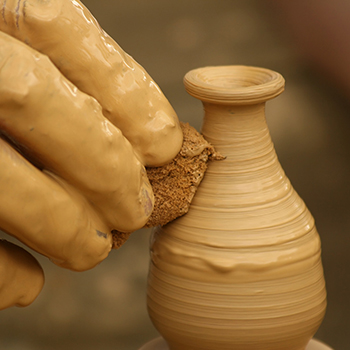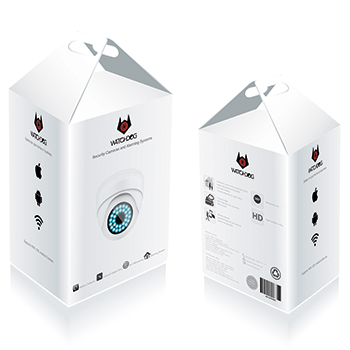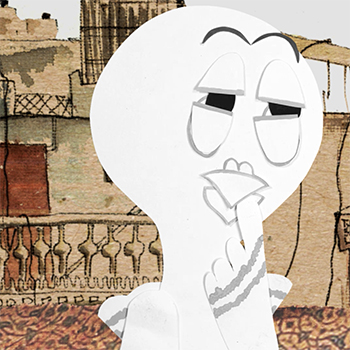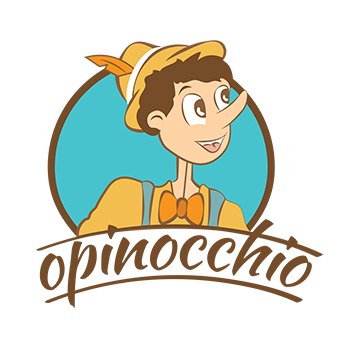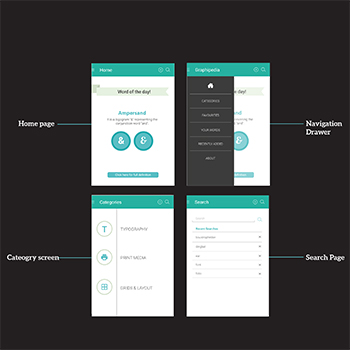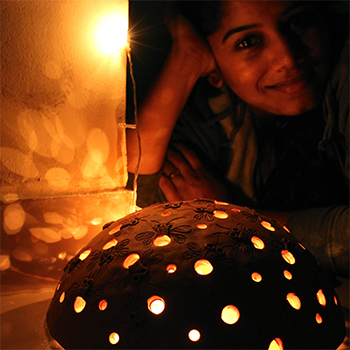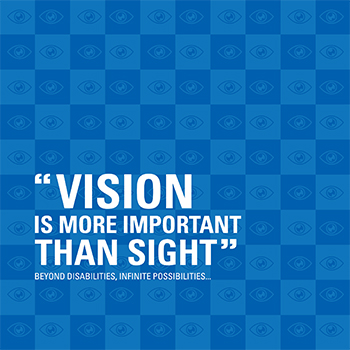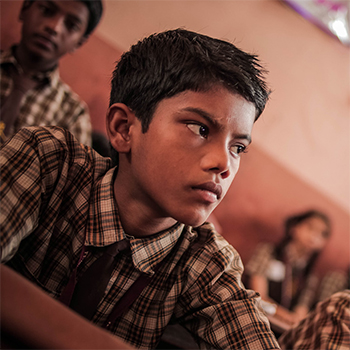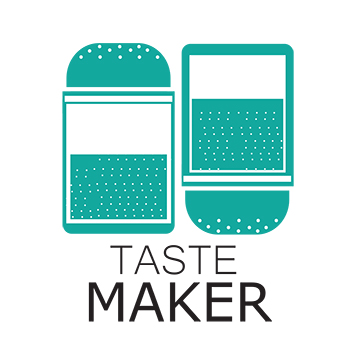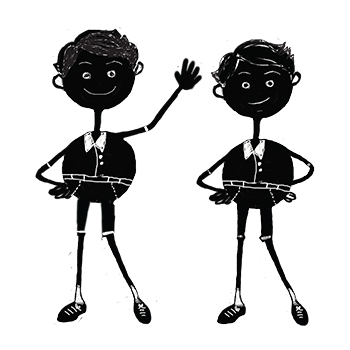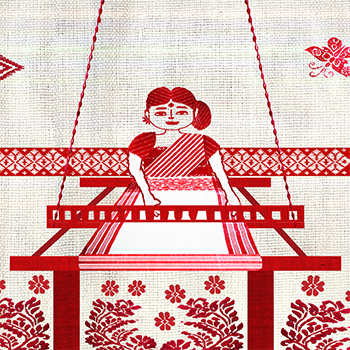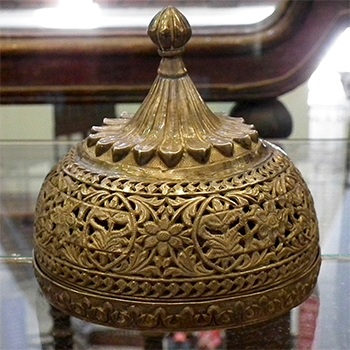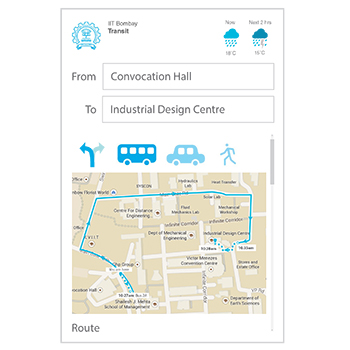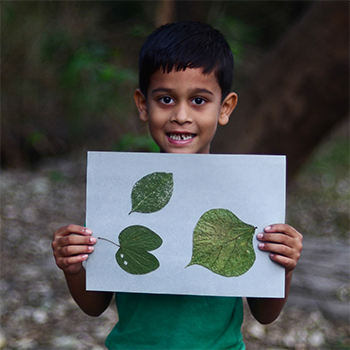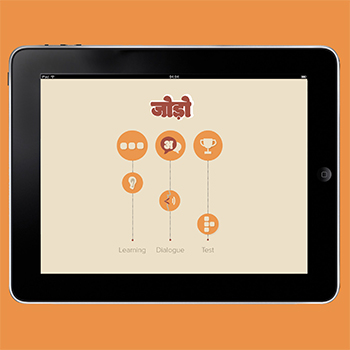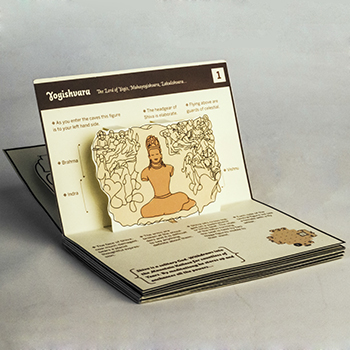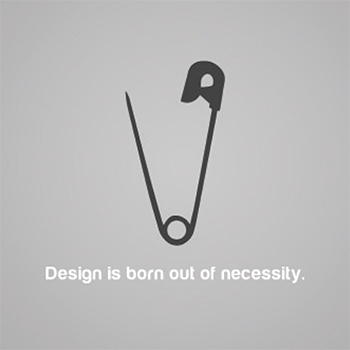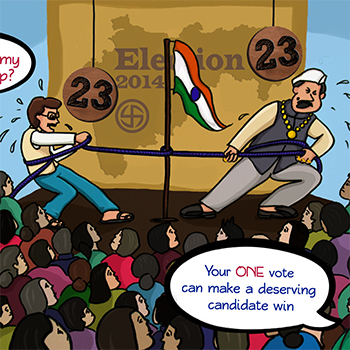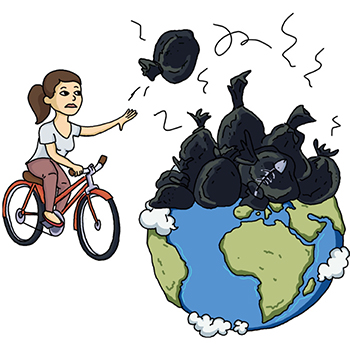Communication Design
Batch 2013-2015
(38 items)
Communication DesignBatch 2013-2015
(38 items)
(38 items)
by Abhey Singh
The world is changing, and with it are its needs and the ways to fulfil them. Jugaad, the concept of using traditional knowledge and combining it with good instincts and common sense, is fast catching on. There are numerous products like Mitticool, a $30 fridge, that are being designed daily by common people. These products are not only easy to produce but also cost-effective at the same time. This phenomenon has brought the process of design closer to the common man.
While a large number of these products have been uncovered in industrial design, very little is done to observe and execute this type of approach in Communication design. Through this project, we want to shed light on one such example of design by common people in the field of Communication design: the system of painting road signs on the highway by mechanics to guide people whose vehicles break down or get punctured. While visual appearance seems to be the most important ingredient of a communication design deliverable when it is taught at design schools, through such examples, we realise that aesthetics can be subjective in relation to the creator and viewer.
by Abhey Singh
by Abhey Singh
Every year, more than a lakh students appear for entrance exams for engineering and medical institutions. The education system, which should nurture the aptitude of students for diverse fields, is a complete failure. This gap between the deliverables of the educational system and the demands of entrance exams, combined with the middle-class definition of success, which is becoming a doctor or an engineer, has fueled the development of entrance exam factories at Kota.
Kota, a name now synonymous with coaching institutes, was once known for reasons not even minutely related to coaching. It has now risen to become the coaching capital of India, with more than 200,000 students residing in this small city. Undergoing the emotional transitions of teenage life, these students work hard day and night to achieve a humble dream: a dream to enter a prestigious engineering or medical institute, a dream to become a doctor or an engineer, a dream to leave behind a financially constrained life, a dream that is the product of simple Indian mentality. Amidst such emotional and lifestyle challenges, a few of them succeed in getting into the premiere institutes. In fact, one-fourth of people who make it into IITs are products of one or more Kota coaching institutes. But this training to become the poster boy or girl does not completely shut out their dreams. These dreams, which may or may not be aligned with their duty to clear the entrance, are expressed in the form of scribbles here and there.
Through this project, I aim to explore the lives of students in Kota. I do not intend to show the "successful" or "unsuccessful" stories. I aspire to show the transformations a student undergoes while being factory trained to explore their dreams through the metaphor ‘The Last Page of a Notebook’. I do not wish to take the position of a judge and justify or criticise the coaching business. Rather, I wish to create sensitivity towards these emotional changes in an unbiased manner.
by Abhey Singh
by Anupriya Kashyap
Pottery in India and the Indian subcontinent dates back thousands of years. Pottery in the early settlements of the Indus Valley civilization was more of a utility than an art; in fact, it was a perfect combination of utility and art. Today in India, Pottery mainly thrives as an art form, and Traditional potters struggle to survive. So what is the reason, how does pottery today relate to each of us, and how will To help pottery survive in the coming times, the following is the topic that we have discussed and pondered upon.
by Anupriya Kashyap
With the increasing rush in metro life, we leave our beloved people and things almost daily. To keep them secure and be satisfied with their well-being. There is an increase in the need for home and business security cameras. The USP of the camera that the company is going to launch is that it is one of the most high-tech cameras with motion detectors, sensors, and an alarm system that is connected to a well-formed network. It also connects and shows the photos on our Android and iOS devices, has connectivity through WiFi, and is accessible through the Internet on the go.
by Anupriya Kashyap
Dog owners always wonder if vaccinations are truly necessary. Vaccines protect pets against contagious and potentially fatal diseases. But many cases of overvaccination and vaccination side effects have created fear among pet owners, and they prefer skipping it or Sometimes pet owners aren’t at all aware of the vaccination schedule and the core and non-core vaccines.
The purpose of this project is to provide dog owners with an Android mobile application that will help them plan a proper vaccination schedule for their pet. It will give them information about the various vaccines that can help them judge the crucial vaccines for your dog without putting your dog through any unnecessary discomfort. The project will also address basic healthcare issues and help the user locate the nearest vet, breeder, or NGO around a location.
by Anupriya Kashyap
Delhi has a long history that has witnessed several dynasties come and go. Great kings longing to leave an impression on the city have given us a veritable treasure trove of monuments. Lal Qila and Qutub Minar are famous across the world. Delhi has a rich and old heritage to show and attract tourists from all over the world and across India too. Because I belong to Delhi and have lived there for almost 22 years, I have experienced and seen Delhi in a very different way than others. I have been to places that are famous as well as places that are not so popular but are part of our rich culture and heritage.
These are the places that somehow get hidden in the spark and reputation of famous monuments, markets, etc. As I have come out of Delhi and made friends from other states of India and abroad, I am still experiencing Delhi in a very different way when I start comparing it with the other states and wonder how different the two states of India can be. Talking to people from other states also gives a different perspective on Delhi, people have their own unique perception of places and people.
So I took on this project where I wanted to give a little glimpse of the experience they might have in terms of the crowd, culture, attire of people, and food through a docudrama. I wanted my first experience handling this medium to demonstrate the good and bad things about Delhi truthfully. a sort of docudrama, which is my own first-hand experience.
by Ayesha Rana
by Ayesha Rana
A Dictionary of Graphic Design
by Ayesha Rana
by Ayesha Rana
by Gauri Karunakara Panicker
"Imagery from Nature on Ceramics," as the title indicates, involved a study of nature and natural forms and creating designs that are characterised by natural forms. A close observation of flowers, leaves, insects, animals, and natural elements and periods like night, water, daylight, air, and fire led to explorations with clay.
The underlying impetus for the project is somewhat similar to that of the Art Nouveau Movement, which arose as a response to the Industrial Revolution and often emphasised utility over aesthetics. The ease of access to diverse cultures in the 21st century makes it different from the period that gave birth to our times, which appears to be the unprecedented exploitation of nature and natural resources. How we relate to nature can shape our lives and those of the planet.
by Gauri Karunakara Panicker
A good design helps deliver any message in a more appealing and effective manner. It can promote your brand, regardless of your business. I wanted to work on the visual design language and learn how it can affect the way we look at a particular company, organisation, or service.
This was the first time that I worked with an NGO. It was an experience where I had to make decisions while working and convince them why they needed the change. I made a visual language for EKansh that could bring more clarity and attention to the work they were doing and their communication media.
by Girish Kumar A M
by Girish Kumar A M
The objective of the summer internship was to understand light. Understanding light is the basis of all photography, for the word photography itself means drawing with light. I wanted to seek out and learn from someone who uses light extensively in all his work.
Light becomes even more critical in Fashion and Advertising photography, as the photographers in this realm are constantly trying to experiment and reinvent themselves. I tried to put myself in the photographer’s shoes and try to understand how he uses different sources of light, to what effect he uses them, and the adjustments he makes to get it absolutely correct.
I also gained insights into people management. The tact with which the photographer balances his client’s needs and his own creative urges It is also interesting to see the manner in which he negotiated with celebrities and their quirks. By the end of my 4-week internship, I had walked away with much more than just an understanding of light.
by Girish Kumar A M
by Girish Kumar A M
Film has displaced the novel as the twentieth century’s most popular narrative form. Yet increasingly, there is a convergence of these two art forms in the sense that major motion picture studios are adapting bestsellers and writers are writing in ways that offer easy adaptation for filmmakers. Furthermore, the novelists are also getting involved in the pre-production of the movie by developing the screenplay of their novels.
This project is an attempt to understand key narrative functions and how the medium of film can be utilised to enunciate the emotion represented through words in the Novel into Visuals that speak to the audience.
by Kavita Brahma
When we talk about Indian Independence, The Khadi revolution marks a pioneering event in terms of freedom, empowerment, and equality. The Khadi revolution embraced the concept of discarding machine-made textiles and creating them at home.
This movement uplifted the concept of hand-woven or self-created textiles among many communities in India. This further led to the development of textiles inspired by the cultural and social environments to which communities belong and provided them with identity in terms of craftsmanship and creativity. One such community is the Sualkuchi community, which used the fibre to become their identity. Therefore, with commercialization and globalisation, they have ushered their identity to such heights that it has given Sualkuchi (Assam) the national identity of being called "the Manchester of the East".
This visual ethnographic study is an attempt to understand the socio-economic influence and struggle of the Sualkuchi community to keep pace with current trends and their traditional essence. This study talks about the complications of surviving and competing in the modern machinery world.
by Kavita Brahma
The report showcases the time spent and work done with a Start-up Online Publication Company called Homegrown: Young India’s Handbook to their Roots and Beyond, based in Bandra, Mumbai. The period of one month was marked as the internship project, which was meant to be the first gateway to experience in the industry. The time period for the internship was from May 6 to July 6, which is four weeks as per the internship guidelines set by the Institute.
The projects involved creating visuals (graphics and illustrations) from the reference content that was provided. All the projects were aimed at giving the content a new dimension, or rather, breaking the convention of the content. The language of the graphics and illustrations was very eccentric.
by Kavita Brahma
Mathematics is a subject that is very closely related to, or rather, derived from, real life. Everybody practises math in each and every step, with or without realising it. For example, A vegetable vendor who might not have had any formal education uses it to sell the goods. In such cases, math is a functional concept that is being developed through repeated practise.
The formal education system also understands its importance and provides it in a very textual form in a book to young minds. The textual form might sometimes fail to help a child visualise how the same given problem relates to the environment. Since the text and the language also define understanding the concept to the core, this can be an issue in a multilingual classroom where the language used in the book is difficult to encode.
Therefore, the project aims to break the barriers of the book language and provide them with a supportive medium in real-life scenarios. The approach involves using elements from the child’s environment and creating them into deliverables such that they are interesting, surprising, and practical at the same time.
by Kavita Brahma
The aim of the project is to explore Assam’s handloom textile motifs as a visual medium for coded messages. The idea is to understand the motifs as a form of communication by the weavers towards the person they are weaving them for. The attempt was to understand the deeper meaning of the distinguishing elements and use the symbolism to depict a story using an amalgamation of the existing traditional technique of weaving with digital art media.
The concept of reviving a traditional medium with the new-age technology of digital media was thoroughly explored. This attempt could provide the different artists, designers, and weavers with a perspective on seeing their practise at a more scalable and experimental level. The project saw growth from an attempt to first understand the motifs to search for a story and then the struggle to understand and learn the traditional technique of weaving to modifying it using digital software to developing a product in terms of a book and further enhancing it to create a 2D animation.
The future of this project could be a series of stories that could be gathered from different parts of the State and compiled through the common loop of the weaver as the main connecting point to each story. For example, The weaver could weave a different motif or a group of motifs and tell a different story every time.
by Pooja Masurkar
Chhatrapati Shivaji Vastu Sangrahalaya and Dr. Bhau Daji Lad Museum have various artefacts on social interaction. The following report exemplifies various types of artefacts used in India. The artefacts documented in this report are: i) jewellery boxes; ii) Vases, Jars, and Flasks iii) Coins; iv) Trays; v) Miscellaneous Artefacts
by Pooja Masurkar
This project would help put technology within reach of rural people and boost their economies. It would further help in bridging the rural-urban divide by enabling self-sustainable rural development by catering to their communication needs. This report is a documentation of the research and study on the existing mobile digital application, Gappagoshti, for rural areas. Problems and solutions for the same have been reported after studying the given screenshots and mock file of the mobile application. Another aspect covered in this report is the study and research on mobile phone utility in an urban household scenario. The problems regarding the same have been reported after surveys and experiments. After analysing the collected data and studying the urban phone usage scenario, solutions and scope for improvement have been suggested. The interface design, information structure, and visual design for mobile banking have also been designed as part of the project.
by Pooja Masurkar
Narrowing down the scale and focusing on one of the solutions to the problems surrounding the transportation issues on campus, this project is an attempt to redesign the existing digital interface, i.e., a website that works on various devices such as smartphones, tablets, and desktop computers and enables a person to search for the most convenient route to her or his desired destination.
The core aim of the project is to empower the end user to save time travelling from one place to another within the campus so that she or he can be more efficient in her or his work. The redesigned interface would enrich the user’s experience using digital media while navigating through the campus in the real world by pinpointing accurate directions and precise timings at which the user will reach the destination.
by Pooja Masurkar
This project aims to build a product that enables foreign tourists visiting India to learn an Indian language spoken in India, i.e., Hindi. The target audience of this product is tourists visiting India for a short period of time, falling in the range of one week to one month. Hence, the user research, study of competitive products in the market, and design of the product were done keeping in mind the needs of this target audience. The design goal is to enable overseas visitors in India for a short duration to converse in Hindi for at least one minute. The process of designing included user research, field visits, study of competitive products in the market, ideating several concepts, understanding the context, imagining scenarios, planning the conversation, system design thinking, interface design, execution of the final product, and evaluating the same with users.
The features of the final product include audio output, translation, vocabulary building, basic grammar, and access to a wide range of phrases and sentences that can be used in common situations that users might encounter during their stay in India. These features integrate the functionality and form of the product. The design focus of this project is the efficient functioning of the product, wherein the purpose of the product and content are supreme. The ideation of the final design concept considers factors such as the time constraints of the visitors, their journey route, and access to the learning application during the same. It complies with responsive design principles and can be accessed on all devices, such as a desktop computer, tablet, or smartphone.
by Shubhangi Salinkar
I visited Dadar Flower Market almost daily. Initially, I was a passive observer and hesitated to intervene in the flurry of activities that were taking place. But I started striking up conversations with the flower sellers bit by bit, and in their free time, they started having conversations with me. I observed it at various times in the day, noticing closely how the activities took place, like garland making, selling, wholesale supplying, clearing, stocking up, etc. I also observed the connections between the various flowers being sold and the market itself: they are intrinsically associated with the time of year, festivals, day of the week, type of buyer, etc. I also observed what was sold in addition to the flowers: leaves, garland-making supplies, and various types of leaves.
by Shubhangi Salinkar
Ladakh is one of the most geographically isolated regions in India. Education in Ladakh is a relatively recent phenomenon. Across an area of about 60,000 square kilometres, that is, Ladakh, about 981 schools of different sizes and categories struggle to exist. Schools in Ladakh belong to three major categories: Private Schools, government schools, and monastery Schools.
The common thread that runs through the different categories of schools across Ladakh is a lack of exposure to the outside world for students and teachers alike. Today, various NGOs are working with Ladakhi schools, providing valuable material resources and sending volunteers to teach the children.
The basic aim of the film is to reach out to the educated people of the country and get them to volunteer in the schools of Ladakh. By documenting the types of schools, the problems they face, and the environments they have, the film is an effort to educate people across the country to spend their time and whatever knowledge they have, with the schoolchildren of Ladakh.
by Shubhangi Salinkar
Nature is fast losing its place in the lives of urban children. The urban child's exposure to nature is largely virtual, through television, the internet, movies, and books. Spending time in nature has been documented to improve a child's life and learning in many ways. Out of the few situations in which urban children do spend time in nature, nature trails were found to be fairly prevalent.
This project aims to create a set of resources to give children a less structured, more enjoyable, yet informative nature experience without a field expert's presence. A self-guided nature trail is conceptualised. Anyone with these resources may initiate their own nature trail. The area selected for the sample nature trail and resources is the IIT-Bombay Lakeside.
This set of resources forms a kit for children, termed as The Little Explorer Bag. It consists of the following items, specifically designed for use by children: A Field Guide for specie identification, an Activity Book, which contains a set of thoughtfully designed, trail-specific activities and information nuggets, a Trail Map of the IIT-B Lakeside Area, and other resources to enable the group to plan and create their own nature trail. It is recommended for an adult to accompany the group of children on the Nature Trail. The use of the kit will enable the children to have an informative as well as an enjoyable nature immersion experience and might act as a trigger to generate sensitivity towards nature in children.
by Shubhangi Salinkar
Over the past few years, more and more people of foreign nationalities have moved to India for purposes other than tourism. In order to feel integrated with the local culture, they often find it necessary to learn the local language. Hindi is widely spoken as either the first or second language across North, Central, and some parts of Western India.
English-speaking foreign nationals face many difficulties in trying to learn Hindi. One of the major difficulties is that the grammatical structure of Hindi is very different from that of English, making it difficult for them to pick up the language without learning the Grammar. Grammar is essential when it comes to sentence-building. It defines the rules by which words come together in a sentence. The identified problem was that the users found it difficult to build sentences with the vocabulary that they had learned or might learn along the way. The objective of the tool was to come up with a sentence-building tool that would help learners internalise grammar rules. Along with building sentences, learning another important skill required by the users—speaking—was also part of the tool.
by Snehal Patil
Classic typefaces are the ones that everybody wants to use over and over again. They are beautiful, and even in today’s day and age, they stand for whatever they were designed for decades ago. Because of the limitations of technology, we might not get the chance to use them in our designs today and treat our eyes to their visual richness. Most of the time, these classic typefaces are found in letterpress punches, photo compositions, or detailed drawings on paper. To use them, we need to revive them from these various mediums in the current digital medium. This serves as an attempt to understand the design thinking behind the creation of classic typefaces.
by Snehal Patil
The Iconomic Meltdown is an event organised by Team Beard Design. It is for enthusiastic Designers who are keen on Designing icons. Icons, especially with Indian aesthetics This Event aims at creating a pool of icons that are free to download and use. This event provides designers with a platform to Design icons in an Indian Scenario. It also provides a collection of new-age, funky Indian Icons.
by Snehal Patil
Historical places in India are visited by all age groups and have become popular tourist spots. It is a gateway for us to connect to the past and learn from our glorious heritage. Most of these sites have tourist guides or information booklets for assistance. Tourists hardly resort to these resources, which are available. The reason is that there is no check on the credibility of the guides, and the information displayed on the pamphlets is not interesting enough for the tourist.
Elephanta Caves is one such beautiful heritage site that needs an information revamp. The aim of this project is to develop an experience for tourists that will be memorable and informative.
by Snehal Patil
The needs of graphic design change over a period of time. Typefaces are designers tools to create strong visuals for flawless communication. There is a growing need for fonts in multiple weights that cater to the requirements of different platforms. Typefaces are generally classified according to their wide usage in text and display. One of the objectives of this project is to bridge the gap between text and display typefaces. So that the requirement can be met with only one font family.
A brief study of devanagari letter structure helped in form exploration. Various calligraphic tools gave direction for creating potential designs. A set of styles for the letterforms was selected to set a guideline for the characteristics that would suit the needs of the project. One such exploration was of geometric rounded letterforms. It proved to be a distinct and interesting approach that could possibly meet the purpose of the project.
A working typeface in three weights, i.e., light, medium, and bold, was created. This typeface is legible in text at small point sizes and is attractive at display sizes. The name of this geometric devanagari typeface is ‘Acacia’.
by Upasana Gadgil
Ceramics has always been a subject of interest to me. Coming across a well-equipped ceramic studio in the Industrial Design Centre during my master's programme raised my excitement to play with clay and make things, which otherwise I would only sketch in my notebook. Imagery from nature on ceramics is a theme taken for a design research seminar project with the intention of understanding how the things we use today are inspired by nature. The beauty of any aesthetically appealing object made by man is indirectly a creation of God since this whole universe is his creation.
Studio work has been a major part of this project, where I experienced the pleasure of making my own clay objects that can actually be used. Made tiny mugs, tiles, jewellery, and other articles. While exploring the methods and techniques to make quality clay articles, I also thought of how making such usable clay articles would benefit small potters in the villages located around Mumbai city and help them earn a better livelihood. This report outlines the detailed design process being followed while creating the clay articles.
by Upasana Gadgil
I chose to work for a product company because I thought it would be a completely new experience for me in terms of understanding the product, its users, and their needs, the design process being followed by the company, dealing with strict deadlines, and working in a team.
I wanted to work on a project that would go live. And this was the main reason I chose "Insights Homepage" as my project, which has a huge scope to work upon. There was a wide scope to improve the user experience, for which I could use my course learning, skills, and knowledge.
This report outlines the design process that I have followed for all three projects. From finding a problem to coming up with an appropriate solution, the details of all the stages are put down clearly so that the reader gets a complete understanding of the end-to-end design process.
by Upasana Gadgil
The Parliament of India is the supreme legislative body of India. The Indian parliament comprises the president and the two houses, the Rajya Sabha (Council of States) and the Lok Sabha (House of the People), which form an important part of our Government System in India. The government of India is the backbone of the country. Every procedural aspect of an Indian citizen’s life is linked directly or indirectly to the Government system. I chose to work on a political science subject for my project because I thought this would be a great opportunity to motivate myself to learn and understand the subject.
I wanted to work on a project that would help people in real life, and the topic that I have chosen, "Parliament of India," gave me a huge scope to work upon. There is a wide scope to improve the transfer of required and important knowledge to the target audience, for which I can use my course learnings, skills, and knowledge.
This report outlines the design process that I have followed throughout the project. The details of deciding a topic, defining the target audience, finding out the problems, and coming up with a set of possible solutions for the same are laid out clearly so that the reader gets a complete understanding of the end-to-end design process.
by Upasana Gadgil


